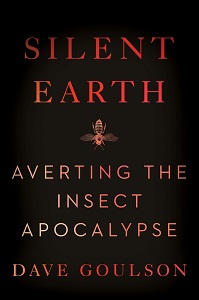
Dave Goulson is an advocate for insects. “Silent Earth: Averting the Insect Apocalypse” is his new book addressing the alarming decline in the populations of these animals who are critical to all other life on Earth.
After a brief history of how insects evolved, he joyfully gives examples of the almost infinite variety of these creatures and how they live, feed, reproduce, and protect themselves. The wonder of metamorphosis is just one example, an amazing life cycle process used by approximately 65% of insect species.
In later chapters, he describes the devastation that is impacting most insects and helps the reader to a different perspective. “On our own planet we are the bad guys, thoughtlessly annihilating life of all kinds for our own convenience.” He blames his own profession as part of the problem: “Ecologists and entomologists should be deeply concerned that we have done such a poor job of explaining the vital importance of insects to the general public.”
Goulson does offer hope and practical solutions. He recommends teaching young children the importance of insects, because most are naturally interested in “bugs” and this may lead to a lifetime of conservation minded decisions. He regrets that teenage and university students are more difficult to reach. He has found that many, even those who choose to study ecology, have little knowledge of the natural world.
He ends the books with specific and doable actions that can be taken by local governments, national governments, farmers, gardeners — and everyone. He encourages all ages to spend more time outside, learning about the variety of life forms, starting with the easiest such as common birds or trees. If people can even name a few animals and plants in nature, they are more likely to be interested in learning about less well-known creatures, and act in ways to protect and promote their well-being.